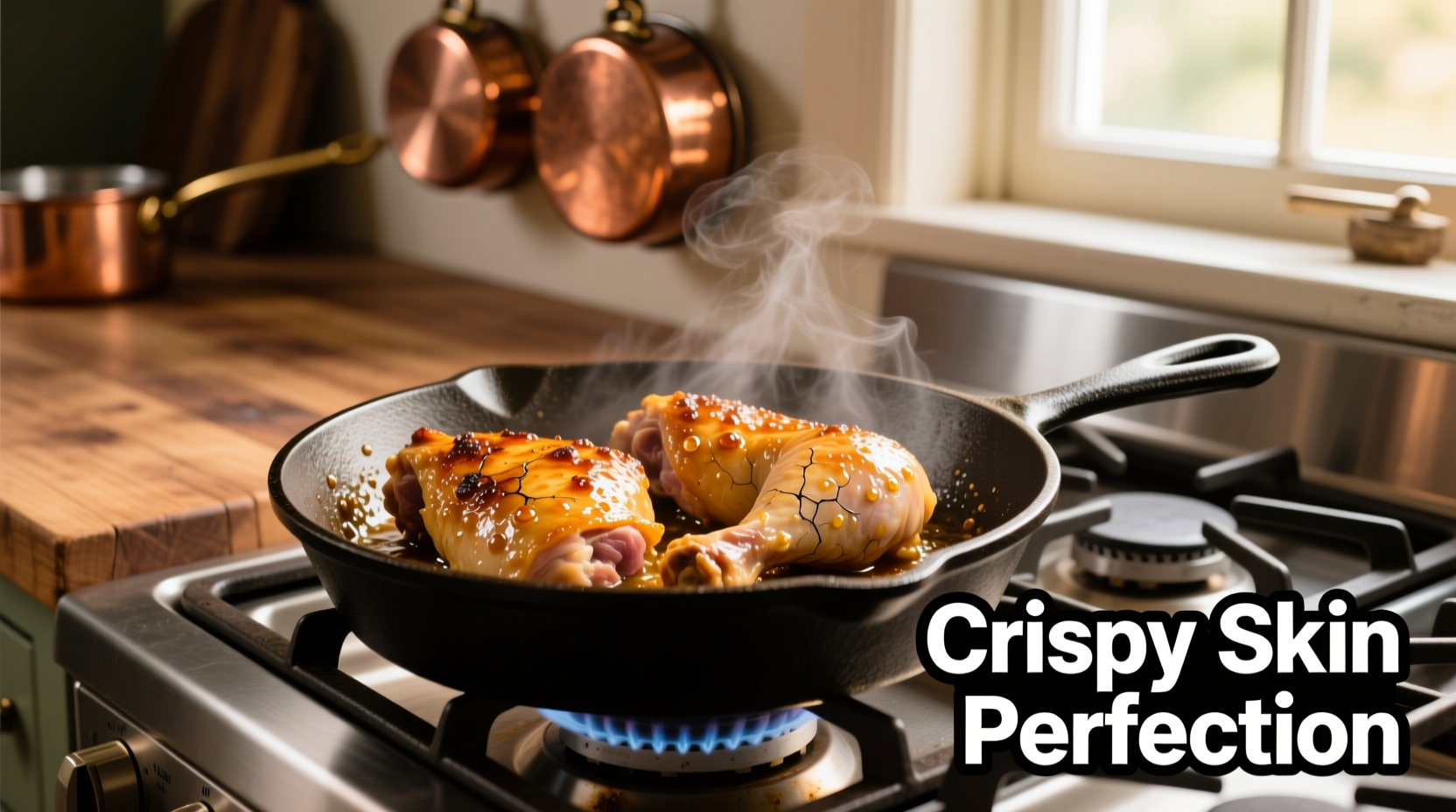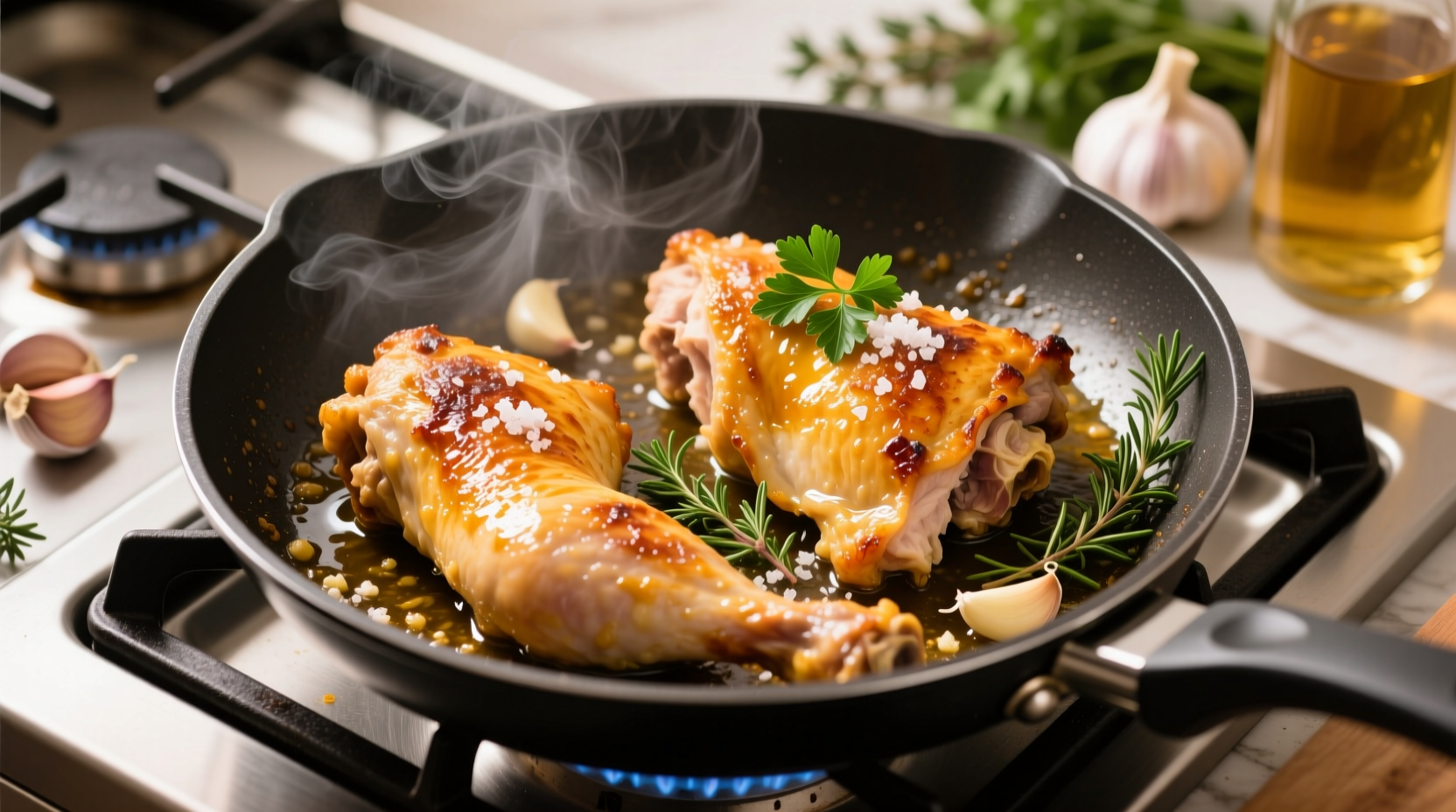For perfectly cooked chicken thighs on stove: Pat thighs dry, season generously, heat oil in cast-iron skillet over medium-high heat, cook skin-side down for 6-8 minutes until golden brown, flip and cook 5-7 minutes more until internal temperature reaches 165°F (74°C). Rest 5 minutes before serving for juicy, flavorful results every time.
Why Mastering Stovetop Chicken Thighs Changes Your Weeknight Cooking
Chicken thighs are the unsung heroes of weeknight cooking—more forgiving than breasts, packed with flavor, and incredibly versatile. When cooked properly on stove, they deliver crispy skin and succulent meat without requiring special equipment. Unlike oven methods that heat your entire kitchen, stovetop cooking gives you precise control over the browning process, which is critical for developing rich flavor through the Maillard reaction.
Professional chefs consistently choose thighs for stove cooking because their higher fat content prevents drying out during the cooking process. According to the USDA Food Safety and Inspection Service, dark meat like thighs maintains moisture better than white meat due to its myoglobin content and fat distribution.
| Cooking Method | Time Required | Skin Crispness | Moisture Retention |
|---|---|---|---|
| Stovetop (bone-in) | 12-15 minutes | ★★★★★ | ★★★★☆ |
| Oven roasting | 35-40 minutes | ★★★☆☆ | ★★★★☆ |
| Air frying | 18-22 minutes | ★★★★☆ | ★★★☆☆ |
Your Essential Equipment Checklist
Before you start cooking chicken thighs on stove, gather these kitchen essentials:
- Heavy-bottomed skillet (cast iron or stainless steel preferred)
- Tongs with good grip for flipping
- Instant-read thermometer (critical for perfect doneness)
- Paper towels for drying chicken
- Splatter screen (optional but recommended)
Why cast iron? According to research from the Culinary Institute of America, cast iron retains heat more evenly than non-stick pans, creating superior browning—a crucial factor when learning how to cook chicken thighs on stove properly. The consistent heat distribution prevents hot spots that can burn the skin while leaving the meat undercooked.

Preparation: The Secret to Success Before You Heat the Pan
The difference between rubbery, unevenly cooked chicken and restaurant-quality results comes down to preparation. Follow these steps for optimal results when cooking chicken thighs on stove:
- Dry thoroughly with paper towels—moisture is the enemy of crispy skin
- Season generously at least 15 minutes before cooking (salt draws out moisture)
- Bring to room temperature for 20-30 minutes before cooking
- Pat dry again immediately before placing in the pan
Food science explains why this matters: moisture on the chicken's surface creates steam when it hits the hot pan, preventing proper browning. The USDA National Agricultural Library confirms that surface moisture must be eliminated for effective Maillard reaction, which creates the complex flavors and appealing brown color.
Step-by-Step Cooking Process: Timing is Everything
Follow this precise method for how to cook chicken thighs on stove with perfect results:
Phase 1: The Critical Sear (6-8 minutes)
- Heat 1-2 tablespoons of high smoke-point oil (avocado or canola) in your skillet over medium-high heat
- Oil is ready when it shimmers but doesn't smoke
- Place thighs skin-side down without crowding the pan
- Resist the urge to move them—this ensures even browning
- Press gently with a spatula for first 30 seconds to ensure full contact
Phase 2: Finishing the Cook (5-7 minutes)
- Flip thighs using tongs when skin releases easily from the pan
- Cook bone-side down until internal temperature reaches 165°F (74°C)
- For extra crispy skin, tilt pan and spoon hot oil over the top for the last 2 minutes
- Check temperature in the thickest part, avoiding bone contact
Timing varies based on thickness and whether your thighs are bone-in or boneless. Bone-in thighs typically need 12-15 minutes total cooking time, while boneless may cook in 10-12 minutes. The Food Safety.gov emphasizes that visual cues alone aren't reliable—always verify with a thermometer.
Troubleshooting Common Stovetop Chicken Problems
Even experienced cooks encounter issues when preparing chicken thighs on stove. Here's how to fix them:
Burnt Skin, Raw Meat
Cause: Heat too high during initial sear
Solution: Start at medium-high, not high heat. If skin browns too quickly, reduce heat immediately.
Rubbery Texture
Cause: Undercooked connective tissue
Solution: Ensure thighs reach proper internal temperature. Dark meat benefits from slightly higher temps (up to 175°F/79°C) for optimal texture.
Excessive Smoke
Cause: Oil smoking point exceeded
Solution: Use avocado oil (smoke point 520°F/271°C) instead of olive oil. Turn on exhaust fan and open windows.
Resting and Serving: Don't Skip This Critical Step
After learning how to cook chicken thighs on stove, proper resting makes the difference between good and exceptional results:
- Transfer cooked thighs to a wire rack or cutting board
- Loosely tent with foil
- Rest for 5-7 minutes before serving
During resting, residual heat continues cooking the meat slightly (carryover cooking), while juices redistribute throughout the tissue. Skipping this step causes precious juices to spill out when you cut into the chicken, resulting in drier meat. This technique is particularly important for bone-in thighs, which have more connective tissue that needs time to relax.
Pro Tips for Flavor Variations
Once you've mastered the basic technique for how to cook chicken thighs on stove, experiment with these professional variations:
- Herb-infused: Add fresh thyme or rosemary sprigs to the pan during the last 3 minutes of cooking
- Lemon-garlic: Add minced garlic and lemon slices to the pan after flipping the chicken
- Spice-rubbed: Apply a dry rub (paprika, garlic powder, onion powder) before cooking for extra flavor dimension
- Simple pan sauce: After removing chicken, deglaze pan with ¼ cup chicken broth and 1 tablespoon butter
Remember that chicken thighs can handle bold flavors better than breasts due to their fat content, which helps carry and mellow strong seasonings. This makes them perfect for experimenting with different spice profiles when cooking chicken thighs on stove.











 浙公网安备
33010002000092号
浙公网安备
33010002000092号 浙B2-20120091-4
浙B2-20120091-4